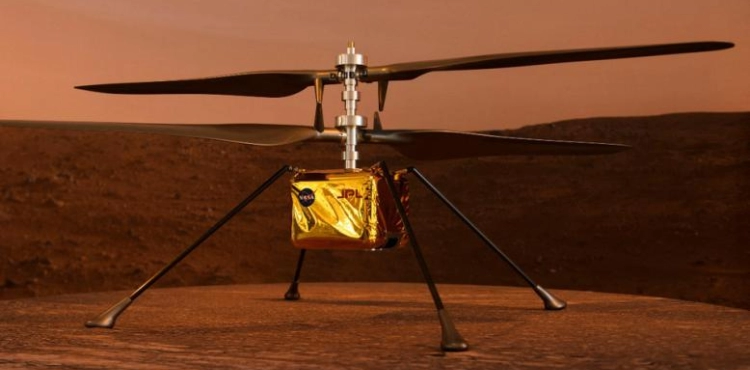The US Space Agency ("NASA") announced that the small "Ingenuity" helicopter installed under the mobile robot "Perseverance" that arrived in February last to Mars, separated from the main vehicle and is now on the surface of the Red Planet.
And the laboratory in charge of the helicopter program at NASA tweeted on Saturday evening, "The Mars helicopter is on the surface!"
The "Ingenuity" was very lightweight, resembling a large drone, folded and installed under the mobile robot "Perseverance" that landed on the surface of the Red Planet on February 18, and remained in place until the robot reached the place from which the helicopter was supposed to take off.
In another tweet, the laboratory indicated that "the (helicopter) flight of 293 million miles (471 million kilometers) ended with this small jump of 4 inches (10 centimeters) from the belly of the probe to the surface of Mars." And he added, "The next test: survival at night."
And a picture accompanying the tweet showed the robot "Perseverance" moving away from the helicopter, and it should move away in less than 25 hours enough to make way for the sunlight that the helicopter needs to generate its energy by solar panels, so that it can warm itself during the cold Mars nights.
Ingenuity has so far secured its power from rover power, but it should be fueling itself anymore.
The chief engineer of the Mars helicopter project, Bob Palram, said, "There is a small coolant that allows to maintain a temperature of about seven degrees Celsius inside the helicopter, while the temperatures at night on Mars drop to minus degrees Celsius."
He explained that this "helps protect the main equipment of the device."
Over the next two days, the ground crew will check whether the solar panels are working as intended, before starting to test engines and sensors before the first sortie, which is not expected to happen before April 11th.
Ingenuity will carry out the first flight of a motor vehicle to a planet other than Earth. If the test is successful, it will be a great achievement, as the density of the Martian atmosphere does not exceed one percent of the density of the Earth´s atmosphere.
This Martian event will be as important as the achievement represented by the first engine-powered flight on the planet in 1903. NASA reported that a small piece of cloth from the Wright Brothers´ plane that took off more than a century ago in North Carolina, was placed on "Ingenuity" in greeting First ground flight, and therefore it is currently on Mars.
It is expected that this first sortie will be very simple, as the helicopter will take off vertically, then it will rise to a height of three meters and hover on this level for 30 seconds and then rotate on itself before landing again.
The helicopter will receive its instructions from Earth a few hours before, but it will itself analyze its position with respect to the surface of Mars during its sortie, by taking 30 pictures per second.
The mobile robot will be stationed at an observation point that will allow it to take pictures with its camera for the "Ingenuity" flight.
NASA intends to conduct up to five sorties spread over a month and are graded in difficulty.
The helicopter consists of four superimposed legs, a chassis and two propellers. It measures 1.2 meters from one end of the blade to the other. The fans run at 2,400 rpm, which is five times faster than a regular raft.
The program of this helicopter cost the agency "NASA" about $ 85 million.
In the future, such vehicles could play a very important role in planet exploration thanks to their ability to reach places that roving robots could not reach (over canyons, for example).
The US Space Agency is working on another pilot project as part of the "Dragonfly" (Dragonfly) mission, which in 2026 will send a drone to Titan, the largest moon of Saturn, to reach it in 2034.
And "NASA" reminded that the flight experiments of vehicles without motors on another planet had already been carried out in the past by sending weather balloons in 1985 to Venus as part of the "Vega" program in which the Soviet Union cooperated with other countries.












